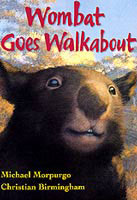Christian Birmingham

Christian Birmingham confounds the notion that children’s books are dashed off over a wet weekend. For one recent tome, Wombat Goes Walkabout, it took Birmingham five months to finish the job, plus two weeks of intensive research in Australia, studying the wombat and other indigenous wildlife.
“Being an artist who lives in southern England, and knowing the book was going to be published in Australia as well as the UK, I felt it was important to get it right. Wombats are commonplace in Australia so my depiction of one needed to be convincing,” he says.
So carried away was he by the exotic fauna down under that Birmingham’s collaborator Michael Morpurgo, whose story it is, found creatures sneaking into the illustrations that he had never even mentioned in the text. Not that he minded too much. They have worked together on eight books now, many of them award-winners, and their mutual respect is such that they allow each other plenty of latitude.
“Christian is enormously sensitive to other people’s ideas, without being overwhelmed by them,” says Morpurgo. “I’m always amazed by the maturity of what he does with my text, how he can get under the skin of things that can seem to be quite trite in isolation and give them some depth.”
The richness of texture, light and detail in Birmingham’s work is all the more surprising when you learn that he works only in colour pastels. “Of all the materials I’ve tried, it’s by far the most cooperative,” he says. His supplier is Cornellison’s in Great Russell Street which he describes as “an Aladdin’s cave for anyone interested in colour”.
After graduating from Exeter College of Art and Design in 1991, Birmingham worked as a graphic designer for three years, working on corporate brochures and, perhaps more significantly, two stamp series for the Royal Mail, one for the Rugby League centenary, the other for Enid Blyton’s centenary.
Knowing that book illustration was his destiny, he teamed up with Morpurgo in 1994 for The Dancing Bear, and collaborated again with Morpurgo the following year for The Wreck of the Zanzibar, which won the Whitbread Children’s Book Award.
Another collaboration with the same author, The Butterfly Lion, was a double award-winner in 1996. The combination of Morpurgo’s imaginative story-telling and Birmingham’s lovingly detailed pictures has proved to be one of the biggest success stories of children’s literature in the 1990s.
Though he has no desire to write his own stories, Birmingham has jumped at the chance to put his distinctive pastel spin on classics such as Oliver Twist, The Lion, The Witch and The Wardrobe, and A Christmas Carol, due to be published by Kingfisher later this year.
-
Post a comment




